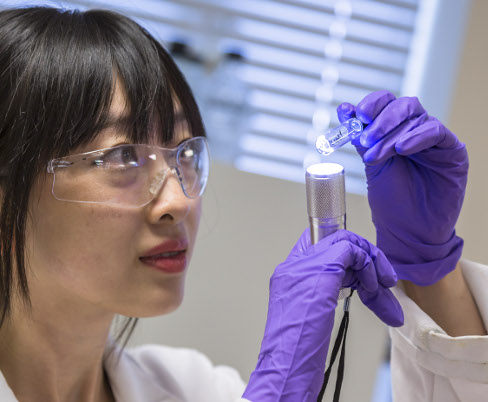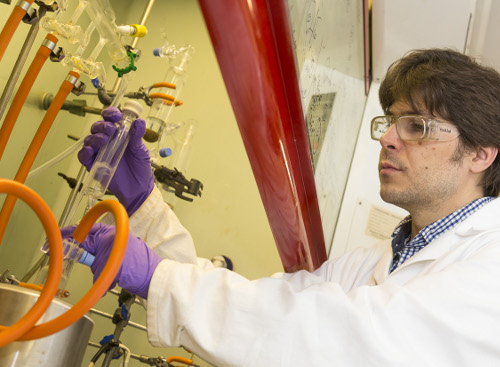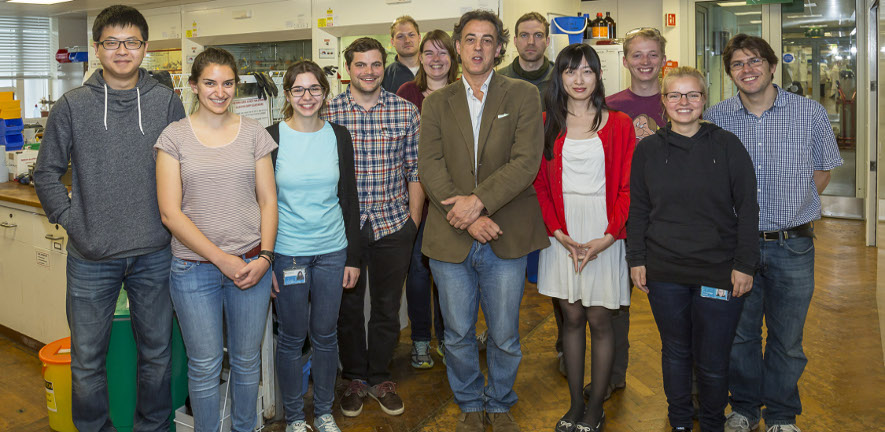
The secret life of a Materials Chemist
Professor Dom Wright is a Synthetic Chemist – or is he? “People think of me as a main group chemist, somebody essentially interested in purely making interesting molecules”, he says.
Dom has always loved molecules, and making them: “A molecule is a beautiful thing – beautiful because it exists and it is interesting to make. That’s what inorganic chemistry is all about.”
But over the years, this love of beautiful molecules has led to crossover research into their material properties – and Dom’s secret life as a materials scientist.
Synthetic vs Materials
It all started in 2007, when Dom began collaborating with Professor Richard Lambert, then in the Chemistry Department (now Emeritus Professor).
Richard was doing work on titanium molecular precursors, and Dom starting working with him to make boron-doped TiO2 for anti-pollution applications. This work led to a joint grant from the EPSRC on metal and non-metal doped TixOy cage molecules. “The cages act like little fragments of titanium oxide and it is possible by examining them to look at how they mimic or mirror bulk samples of the same material,” says Dom.
Not only can these small molecules be used to predict what will happen with larger in bulk TiO2, but they also have interesting properties in their own right. For example, Dom became interested in discovering what factors affect the band gap properties of these large cage compounds.
“We were able to show that you can reduce the energy of electronic excitation by having a large dipole moment in the cage. So if you have a molecule with a net polarity, that can drastically affect the way electrons move within the molecule. That’s related to the way the metal-doped TiO2 itself behaves.”

Although the TiO2 work first sparked Dom’s interest in the materials applications of his research, over the years Dom’s group continued its work on the systematic assembly of inorganic molecules. They have pioneered new synthetic methods for the synthesis of heterometallic imido and phosphinidene cage compounds, developed new approaches to magnetic molecules and targeted the synthesis of main group macrocycles.
But Dom also maintained his interest in the material properties of the resultant molecules, through his collaborations in the Chemistry department with Professor Clare Grey, Professor Ali Alavi and Dr Erwin Reisner.
Sustainable sources of energy
Erwin Reisner’s research focuses on creating sustainable sources of energy by using visible light to split water into hydrogen and oxygen. Dom and Erwin worked together to create an efficient, stable and scalable hybrid photoelectrode to improve this process. Erwin’s group was developing a photocathode which consisted of a p-type Si substrate. “As part of this, my group created little molecules which decomposed to make small Ti and Ni-containing composite films,” says Dom. These films act as both a protection and electrocatalyst layer on the substrate. “We can create molecules with precise known amounts of titanium oxide, and we can measure how this affects the material properties of the substrate and consequently the photocathode.” 
Battery electrolytes
In collaboration with Clare Grey, Dom has been looking for new types of battery electrolytes based on metals other than lithium, which may become a scarce metal in the future. Using basic organic synthesis methods, Dom is attempting to created new salts based on more plentiful metal salts such as magnesium and sodium. These salts can then be tested as new electrolytes for unconventional batteries.
Testing predictions
Dom’s latest work has been with Ali Alavi, who made predictions about the material properties of non-metal doped graphite. Ali suspected that C3B should have hydrogen storage properties and other theoreticians indicated that it should also have high lithium storage capacity too, which could have implications for improved energy storage.
As a theoretician, Ali based his predictions on standard quantum chemical techniques. Dom’s group devised a chemical way to make samples of C3B in a precise stoichiometric arrangement for the first time, making it possible to test whether Ali’s predictions about their material properties were correct. The results of this research are about to be published in Angewandte Chemie.
“I am interested in making the molecules themselves as beautiful things, but on the materials side I can start to explain why these molecules are useful, which adds an extra layer of interest.”
It seems that through these latest projects, Dom’s secret world of materials chemistry will no longer be a secret.
References:
Effective Visible Light-Activated B-Doped and B,N-Codoped TiO2 Photocatalysts, S. In, A. Orlov, R. Berg, F. García, S. Pedrosa-Jimenez, M. S. Tikhov, D. S. Wright, and R. M. Lambert, J. Am. Chem. Soc., 2007, 129: 13790.
A Si Photocathode Protected and Activated with a Ti and Ni Composite Film for Solar Hydrogen Production, Lai YH, Park HS, Zhang JZ, Matthews PD, Wright DS, Reisner E., Chem. Eur. J., 2015, 21: 3919-3923
Ab initio structure search and in situ 7Li NMR studies of discharge products in the Li-S battery system, Kimberly A. See, Michal Leskes, John M. Griffin, Sylvia Britto, Peter D. Matthews, Alexandra Emly, Anton Van der Ven, Dominic S. Wright, Andrew J. Morris, Clare P. Grey and Ram Seshadri, J. Am. Chem. Soc., 2014, 136(46): 16368-16377.
Dipole-Induced Band-Gap Reduction in an Inorganic Cage, Yaokang Lv, Dr Jun Cheng, Dr Alexander Steiner, Prof. Lihua Gan and Prof. Dominic S. Wright, Angew. Chem. Int. Ed., 53: 1934-1938.

All photos courtesy of Nathan Pitt, Department of Chemistry.
Top: Professor Dom Wright;
Middle left: BP-funded PhD student Bihan Gaun inspects a vial looking for single crystals which she is growing for X-ray crystallography;
Middle right: Dr R Garcia-Rodriguez conducting a reaction;
Bottom: The Wright Research Group.

